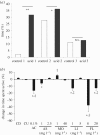Evolution of nociception and pain: evidence from fish models
- PMID: 31544617
- PMCID: PMC6790376
- DOI: 10.1098/rstb.2019.0290
Evolution of nociception and pain: evidence from fish models
Abstract
In order to survive, animals must avoid injury and be able to detect potentially damaging stimuli via nociceptive mechanisms. If the injury is accompanied by a negative affective component, future behaviour should be altered and one can conclude the animal experienced the discomfort associated with pain. Fishes are the most successful vertebrate group when considering the number of species that have filled a variety of aquatic niches. The empirical evidence for nociception in fishes from the underlying molecular biology, neurobiology and anatomy of nociceptors through to whole animal behavioural responses is reviewed to demonstrate the evolutionary conservation of nociception and pain from invertebrates to vertebrates. Studies in fish have shown that the biology of the nociceptive system is strikingly similar to that found in mammals. Further, potentially painful events result in behavioural and physiological changes such as reduced activity, guarding behaviour, suspension of normal behaviour, increased ventilation rate and abnormal behaviours which are all prevented by the use of pain-relieving drugs. Fish also perform competing tasks less well when treated with a putative painful stimulus. Therefore, there is ample evidence to demonstrate that it is highly likely that fish experience pain and that pain-related behavioural changes are conserved across vertebrates. This article is part of the Theo Murphy meeting issue 'Evolution of mechanisms and behaviour important for pain'.
Keywords: analgesia; animal behaviour; fishes; invertebrates; nociceptors; zebrafish.
Conflict of interest statement
I have no competing interests.
Figures


References
-
- IASP. 2019. IASP Terminology. Pain Terms. Washington, DC: International Association for the Study of Pain; See https://www.iasp-pain.org/Education/Content.aspx?ItemNumber=1698&navItem... (accessed 8 March 2019).
-
- Sneddon LU, Elwood RW, Adamo S, Leach MC. 2014. Defining and assessing pain in animals. Anim. Behav. 97, 201–212. (10.1016/j.anbehav.2014.09.007) - DOI
-
- Donoghue PCJ, Purnell MA. 2009. The evolutionary emergence of vertebrates from among their spineless relatives. Evol. Educ. Outreach 2, 204–212. (10.1007/s12052-009-0134-3) - DOI
Publication types
MeSH terms
Grants and funding
LinkOut - more resources
Full Text Sources
Medical

